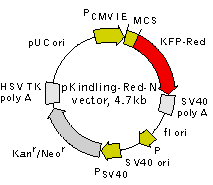
|
||||||||||
|
||||||||||

|
|
||||||||||||||||||||||||||||||||||||||||||||||||||||||||||||||||||||||||||||||||||||||||||||||||||||||||||||||||||||||||||||||||||||||||||||||||||||||||||||||||||||||||||||||||||||||||||||||||||||||||||
The vector sequence has been compiled using the information from sequence databases, published literature, and other sources, together with partial sequences obtained by Evrogen. This vector has not been completely sequenced. |
|||||||||||||||||||||||||||||||||||||||||||||||||
 Download
|
| ||||||||||||||||||||||||||||||||||||||||||||||||
| Nhe I | Bgl II | Sac I | Hind III | EcoR I | Sal I | Kpn I | Apa I | BamH I | Age I | KFP-Red | |||||||||||||||||||
| Afe I | Xho I | Pst I | Sac II | Nco I* | |||||||||||||||||||||||||
| GCT | A.GC | G.CT | A.CCG.GAC.TC | A.GAT. | CT | C. | GAG. | CTC. | AAG.CTT. | C | GA.ATT. | C | TG.CA | G. | TCG.AC | G.GTA. | CC | G.C | GG. | G | CC.C | G | G.G | AT.CC | A.CCG.GT | C.GCC.A | CC. | ATG.G | CC |
* – not unique site.
Vector description
pKindling-Red-N is a mammalian expression vector encoding kindling red fluorescent protein
The vector backbone contains immediate early promoter of cytomegalovirus (PCMV IE) for protein expression, SV40 origin for replication in mammalian cells expressing SV40 T-antigen, pUC origin of replication for propagation in
SV40 early promoter (PSV40) provides neomycin resistance gene (Neor) expression to select stably transfected eukaryotic cells using G418. Bacterial promoter (P) provides kanamycin resistance gene expression (Kanr) in
Generation of
A localization signal or a gene of interest can be cloned into MCS of the vector. It will be expressed as a fusion to the
Note: The plasmid DNA was isolated from dam+-methylated
Expression in mammalian cells
pKindling-Red-N vector can be transfected into mammalian cells by any known transfection method. CMV promoter provides strong, constitutive expression of
Propagation in
Suitable host strains for propagation in
Location of features
PCMV IE: 1-589
Enhancer region: 59-465
TATA box: 554-560
Transcription start point: 583
MCS: 591-671
Kozak consensus translation initiation site: 672-682
Start codon (ATG): 679-681
Stop codon: 1375-1377
SV40 early mRNA polyadenylation signal
Polyadenylation signals: 1530-1535 & 1559-1564
mRNA 3' ends: 1568 & 1580
f1 single-strand DNA origin: 1627-2082
Bacterial promoter for expression of Kanr gene
-35 region: 2144-2149
-10 region: 2167-2172
Transcription start point: 2179
SV40 origin of replication: 2423-2558
SV40 early promoter
Enhancer (72-bp tandem repeats): 2256-2327 & 2328-2399
21-bp repeats: 2403-2423, 2424-2444 & 2446-2466
Early promoter element: 2479-2485
Major transcription start points: 2475, 2513, 2519 & 2524
Kanamycin/neomycin resistance gene
Neomycin phosphotransferase coding sequences:
Start codon (ATG): 2607-2609
Stop codon: 3399-3401
G->A mutation to remove Pst I site: 2789
C->A (Arg to Ser) mutation to remove BssH II site: 3135
Herpes simplex virus (HSV) thymidine kinase (TK) polyadenylation signal
Polyadenylation signals: 3637-3642 & 3650-3655
pUC plasmid replication origin: 3986-4629
References:
- Gorman C. High efficiency gene transfer into mammalian cells. In DNA cloning: A Practical Approach, Vol. II. Ed. D. M. Glover. (IRL Press, Oxford, U.K.). 1985; 143-90.
- Haas J, Park EC, Seed B. Codon usage limitation in the expression of HIV-1 envelope glycoprotein. Curr Biol. 1996; 6 (3):315-24. / pmid: 8805248
- Kozak M. An analysis of 5'-noncoding sequences from 699 vertebrate messenger RNAs. Nucleic Acids Res. 1987; 15 (20):8125-48. / pmid: 3313277
Notice to Purchaser:
KFP-Red-related materials (also referred to as "Products") are intended to be used by academic (non-commercial) entities and for research purposes only. Any use of the proprietary nucleic acid or protein other than for research use or by a commercial entity is strictly prohibited. Transfer of this product by purchaser to any other party is specifically prohibited.
|
Copyright 2002-2023 Evrogen. All rights reserved. Evrogen JSC, 16/10 Miklukho-Maklaya str., Moscow, Russia, Tel +7(495)988-4084, Fax +7(495)988-4085, e-mail:evrogen@evrogen.com |


